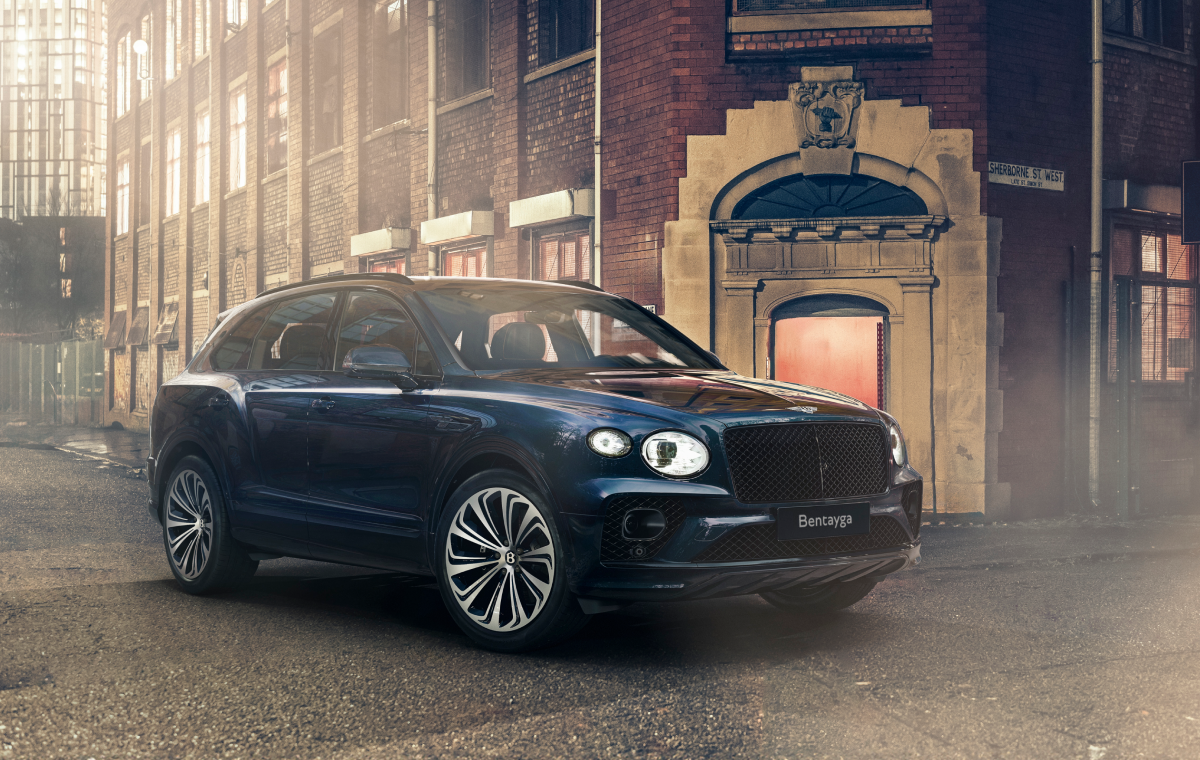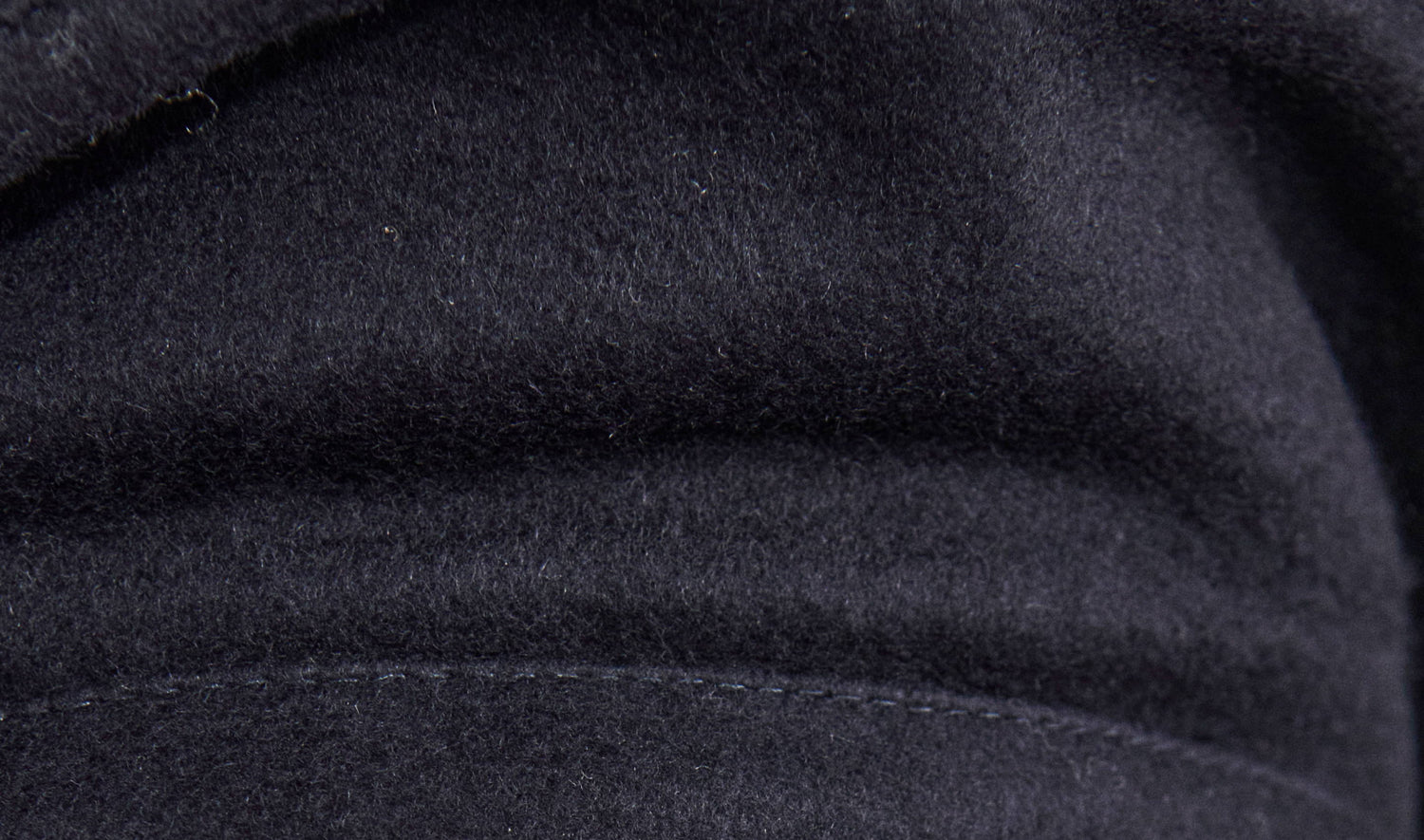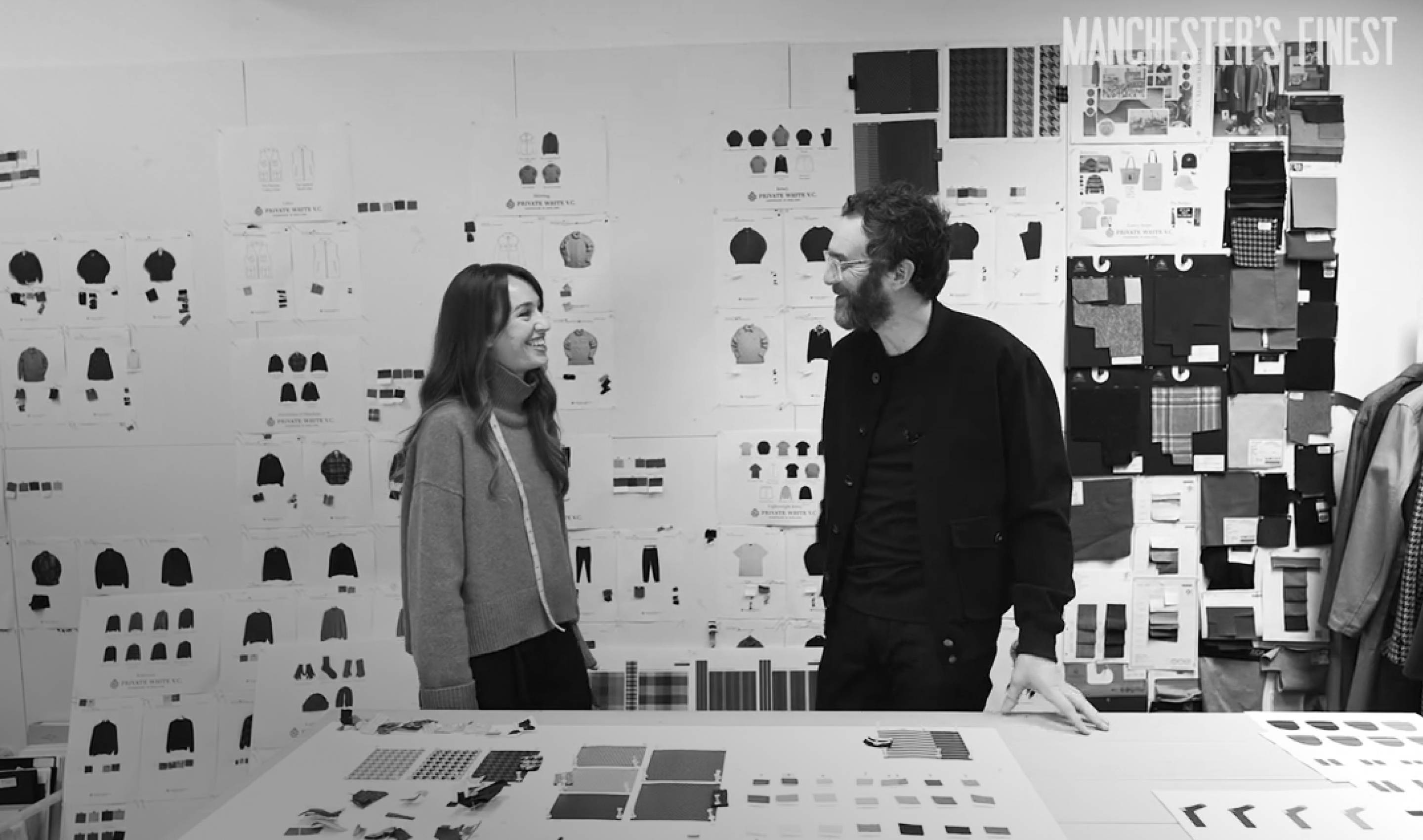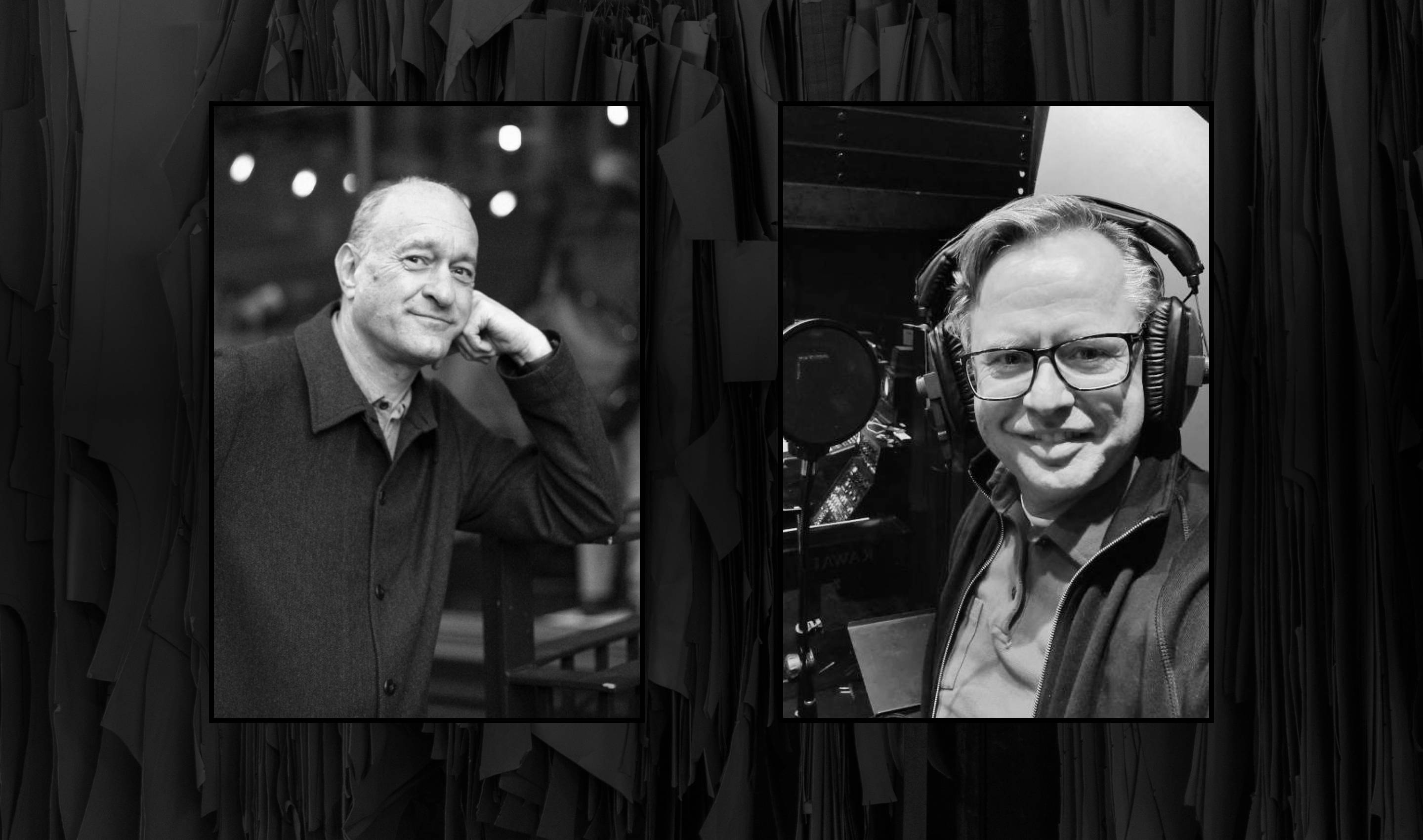Mallelieus Factory Visit
We are lucky enough to be surrounded by some of the world’s finest cloth makers and spinners. Recently, the Private White team travelled a short 20-minute drive to Delph from inner city Manchester, through rolling countryside, to see where the historic doeskin yarn is spun, right on the doorstep of our 169-year-old red-bricked factory.
Valley Hill, nestled in a charming, quaint Pennine village, has been home to our lifelong friends Mallalieus for more than 150 years. They’re synonymous with the most beautiful, luxurious British-made woolen cloths. It’s one of the few traditional vertical mills in the British Isles and the visit seemed perfect timing, given our new iteration of the Frobisher (using yarn from the spinner here), has just been released.
Mallelieus Factory Visit
We are lucky enough to be surrounded by some of the world’s finest cloth makers and spinners. Recently, the Private White team travelled a short 20-minute drive to Delph from inner city Manchester, through rolling countryside, to see where the historic doeskin yarn is spun, right on the doorstep of our 169-year-old red-bricked factory.
Valley Hill, nestled in a charming, quaint Pennine village, has been home to our lifelong friends Mallalieus for more than 150 years. They’re synonymous with the most beautiful, luxurious British-made woolen cloths. It’s one of the few traditional vertical mills in the British Isles and the visit seemed perfect timing, given our new iteration of the Frobisher (using yarn from the spinner here), has just been released.
On our quest to make exemplary garments, our search for the finest regionally sourced materials has taken us on travels near and afar to countless mills, ateliers, factories and workshops over the years. All of which have something new to offer in terms of showcasing a passion for quality, time-honoured techniques and craft. But it’s Mallalieus that has stood strong for more than a century, like ourselves, surviving the test of time.
As soon as we were shown around by Managing Director Clive Walsh, it was clear to see why our doeskin fabric is so special and why we love these factory visits so much. Clive explains: “We control every single process required over two sites here at Valley Hill from dying and blending to carding, spinning, weaving and finishing. It’s what makes us so unique.”
From the waiting room, adorned with colourful fabric swatches, raw materials and historic memorabilia, we were given an access-all-areas tour of all machines, processes and an extremely well-run factory.
Below you can see the carding in action, where the wool is pulled apart in straight lines, the fibres are pulled in one direction in preparation for spinning. At this stage, the yarn has no strength, you can pull them apart quite easily.
“Doeskin is made using this process with white ecru yarn (it’s dyed after it’s woven), it’s quite a fine yarn as you can see. Next, it’s separated for spinning which gives it its strength, it’s a very important stage,” Clive continues.
Spinning is where the twists and turns are put into a yarn, the more twists, the harder a fabric will be (for upholstery fabrics) and the less turns, the softer the fibre will be. With doeskin, the fibres are longer and softer. Our doeskin is a medium-weight wool fabric with a short nap and tight weave. It is softer than the more commonly used melton but it is still very hardwearing due to its compact weave and construction.
After spinning, the yarn is loaded onto looms for warping. A woven fabric comprises of yarns running its length – the warp – and interlacing yarns across its width – the weft. Warping is the first step in the fabric manufacturing process. Here, the doeskin is unrecognisable in its current state to the finished fabric we buy.
Next in the manufacturing process is weaving. Mallalieus has 24 looms which are busy in action as the warp (vertical) and weft (horizontal) yarns are interlaced to weave desired patterns. It’s loom 20 which catches our attention, where the doeskin fabric is carefully being woven with exact precision.
One of the most important areas we come to along our tour across the cobbled-lined courtyard is the mending room. It’s here we're introduced to Andrea, who has worked in QC for nearly five decades since she finished school at 18, perfecting her time-honoured skill of fixing fabrics by eye and hand. “It takes over a day to appraise and assess every roll, some fabrics need a different degree of mending, others you need to spend a lot more time on. It’s my job to fix every missing stitch and knot. It’s highly skilled,” she explains.
Clive takes us to the other side of the mending room which he is exhilarated about: “This is your finished fabric; others feel like a sack of spuds compared to yours. This is it in its pre-dyed state, but we check it’s at the correct grade spade, it’s dyed and then comes back for finishing. It’s an extremely detailed process and takes three weeks to complete,” he adds.
At Valley Mill, some of the traditional machinery dates back to the beginning of the mid 19th century when the factory was set up. Clive introduces us to the Decatizing Machine, which processes our exclusive doeskin cloth that we proudly use on both our Flight Jacket and recently launched Frobisher update.
“We’re quite skilled and specialised in this side of things. To my knowledge this machine is the only one left in existence in the UK, the technique is done after dying. Doeskin is made with a white ecru yarn, it’s quite a fine yarn. We do a lot of yarns, but yours is of better quality because it goes through this machine, it’s the only cloth in the mill to do so. It’s a high-pressure press that uses heat at the same time, the fabric goes through wet, which gives it that added sheen and softness. It’s quite individual. It gets a waterproof coating, put through at a slow speed. It’s a permanent finish, no matter how much you put it in the wash, it’s waterproof.”
By the time we’ve finished the impressive two-hour tour and talked in length about factory life, we have a greater sense of understanding and appreciation of where one of our bestselling cloth is made. Now back at Cottenham House, the roll of doeskin fabric on the cutting room floor has a much deeper connection and emotional depth when constructed into the Frobisher and for whoever will wear it for years to come.
With thanks to Clive and his incredible team at at Mallalieus Delph.
On our quest to make exemplary garments, our search for the finest regionally sourced materials has taken us on travels near and afar to countless mills, ateliers, factories and workshops over the years. All of which have something new to offer in terms of showcasing a passion for quality, time-honoured techniques and craft. But it’s Mallalieus that has stood strong for more than a century, like ourselves, surviving the test of time.
As soon as we were shown around by Managing Director Clive Walsh, it was clear to see why our doeskin fabric is so special and why we love these factory visits so much. Clive explains: “We control every single process required over two sites here at Valley Hill from dying and blending to carding, spinning, weaving and finishing. It’s what makes us so unique.”
From the waiting room, adorned with colourful fabric swatches, raw materials and historic memorabilia, we were given an access-all-areas tour of all machines, processes and an extremely well-run factory.
Below you can see the carding in action, where the wool is pulled apart in straight lines, the fibres are pulled in one direction in preparation for spinning. At this stage, the yarn has no strength, you can pull them apart quite easily.
“Doeskin is made using this process with white ecru yarn (it’s dyed after it’s woven), it’s quite a fine yarn as you can see. Next, it’s separated for spinning which gives it its strength, it’s a very important stage,” Clive continues.
Spinning is where the twists and turns are put into a yarn, the more twists, the harder a fabric will be (for upholstery fabrics) and the less turns, the softer the fibre will be. With doeskin, the fibres are longer and softer. Our doeskin is a medium-weight wool fabric with a short nap and tight weave. It is softer than the more commonly used melton but it is still very hardwearing due to its compact weave and construction.
After spinning, the yarn is loaded onto looms for warping. A woven fabric comprises of yarns running its length – the warp – and interlacing yarns across its width – the weft. Warping is the first step in the fabric manufacturing process. Here, the doeskin is unrecognisable in its current state to the finished fabric we buy.
Next in the manufacturing process is weaving. Mallalieus has 24 looms which are busy in action as the warp (vertical) and weft (horizontal) yarns are interlaced to weave desired patterns. It’s loom 20 which catches our attention, where the doeskin fabric is carefully being woven with exact precision.
One of the most important areas we come to along our tour across the cobbled-lined courtyard is the mending room. It’s here we're introduced to Andrea, who has worked in QC for nearly five decades since she finished school at 18, perfecting her time-honoured skill of fixing fabrics by eye and hand. “It takes over a day to appraise and assess every roll, some fabrics need a different degree of mending, others you need to spend a lot more time on. It’s my job to fix every missing stitch and knot. It’s highly skilled,” she explains.
Clive takes us to the other side of the mending room which he is exhilarated about: “This is your finished fabric; others feel like a sack of spuds compared to yours. This is it in its pre-dyed state, but we check it’s at the correct grade spade, it’s dyed and then comes back for finishing. It’s an extremely detailed process and takes three weeks to complete,” he adds.
At Valley Mill, some of the traditional machinery dates back to the beginning of the mid 19th century when the factory was set up. Clive introduces us to the Decatizing Machine, which processes our exclusive doeskin cloth that we proudly use on both our Flight Jacket and recently launched Frobisher update.
“We’re quite skilled and specialised in this side of things. To my knowledge this machine is the only one left in existence in the UK, the technique is done after dying. Doeskin is made with a white ecru yarn, it’s quite a fine yarn. We do a lot of yarns, but yours is of better quality because it goes through this machine, it’s the only cloth in the mill to do so. It’s a high-pressure press that uses heat at the same time, the fabric goes through wet, which gives it that added sheen and softness. It’s quite individual. It gets a waterproof coating, put through at a slow speed. It’s a permanent finish, no matter how much you put it in the wash, it’s waterproof.”
By the time we’ve finished the impressive two-hour tour and talked in length about factory life, we have a greater sense of understanding and appreciation of where one of our bestselling cloth is made. Now back at Cottenham House, the roll of doeskin fabric on the cutting room floor has a much deeper connection and emotional depth when constructed into the Frobisher and for whoever will wear it for years to come.
With thanks to Clive and his incredible team at at Mallalieus Delph.
















Leave a comment
This site is protected by hCaptcha and the hCaptcha Privacy Policy and Terms of Service apply.